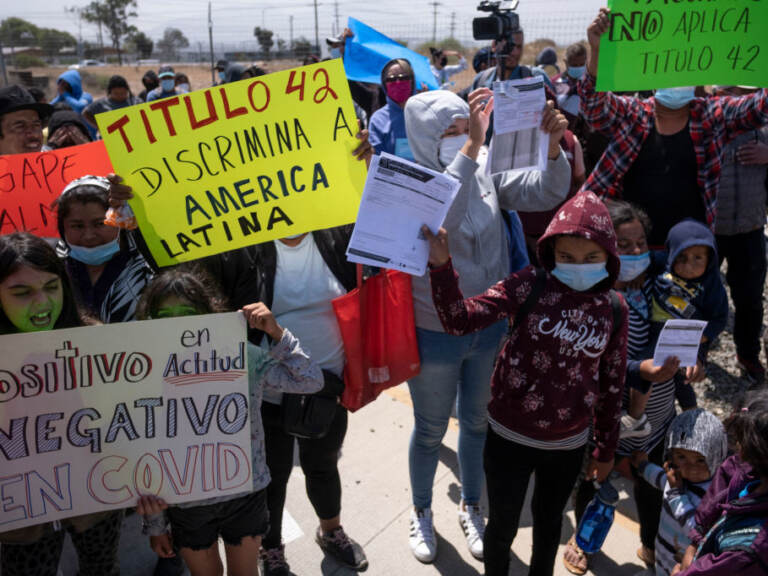Judge rules that pandemic border restrictions must continue, a win for GOP-led states

Migrants and asylum seekers protest outside the United States Consulate against the public health order known as Title 42, in Tijuana, Mexico, on May 19, 2022. (Guillermo Arias/AFP via Getty Images)
A federal judge has blocked the Biden administration from lifting the pandemic border restrictions known as Title 42 next week.
That public health order, which had been set to end on Monday, allows immigration authorities to quickly expel migrants at the border without allowing them to seek asylum.
The ruling is a victory for the Republican-led states that are pushing to extend the restrictions.
More than 20 states signed on to a lawsuit brought by Arizona, Missouri and Louisiana. They argued that the Centers for Disease Control and Prevention did not go through the proper procedures to end Title 42, and should have considered the impact on state health care systems and other costs.
U.S. District Judge Robert Summerhays in Louisiana granted the preliminary injunction those states had been seeking, saying they were likely to prevail on their claim.
“Today’s ruling is a significant win as Title 42 is one of the few immigration policies that is actually working,” said Arizona Attorney General Mark Brnovich in a statement.
The CDC first authorized the Title 42 restrictions in March of 2020, saying they were necessary to stop the spread of COVID-19. In April of this year, the CDC said those restrictions were no longer necessary to protect public health, and moved to terminate the policy on May 23rd.
The preliminary injunction was not unexpected. Judge Summerhays had already granted a temporary restraining order in the case, and indicated that he was sympathetic to the states’ arguments.
Still, immigrant advocates were disappointed.
“Title 42 and this lawsuit were never about public health but a transparent attempt to end asylum,” said Lee Gelernt, an attorney with the American Civil Liberties Union, which has been challenging the legality of the public health order in a separate case.
“If the administration doesn’t immediately seek to undo the injunction, it will say a lot about whether the White House truly wants Title 42 to end,” Gelernt said.
The Department of Justice says it intends to appeal the ruling.
“CDC has now determined, in its expert opinion, that continued reliance on this authority is no longer warranted in light of the current public-health circumstances,” said Justice Department spokesman Anthony Coley in a statement. “That decision was a lawful exercise of CDC’s authority.”
The injunction leaves tens of thousands of migrants in limbo in cities and towns south of the U.S.-Mexico border.
“Title 42 has had a catastrophic effect on asylum seekers,” said Sameera Hafiz, the policy director with the Immigrant Legal Resource Center.
“Border officials have the ability to employ measures recommended by public health experts to keep asylum seekers safe as they seek refuge in the U.S. There is no excuse for the continuation of Title 42, other than allowing the anti-immigrant playbook to continue,” Hafiz said in a statement.
The Department of Homeland Security has been preparing for a possible influx of migrants when Title 42 ends. Earlier this week, Homeland Security Secretary Alejandro Mayorkas met with border patrol agents in the Rio Grande Valley, and pledged to scale up the enforcement of normal U.S. immigration laws when Title 42 is lifted.
“We will be increasing the number of criminal prosecutions to meet the challenge,” Mayorkas said during a press conference on Tuesday.
Since it was put in place by the Trump administration, Title 42 has sharply limited the number of migrants who can seek asylum at the southern border. But migrants who are quickly expelled under the policy are also shielded from criminal prosecution. Mayorkas and other administration officials argue that restoring those consequences will help to deter migrants from crossing repeatedly, and drive border numbers down.
The Biden administration has faced bipartisan criticism for moving to end Title 42 at a time when border apprehensions are near record levels.
Immigration authorities encountered migrants at the southern border more than 234,000 times in April, according to U.S. Customs and Border Protection. That’s one of the highest totals ever recorded, although tens of thousands of migrants crossed multiple times and were counted more than once in the total.
The April total also includes more than 20,000 Ukrainians fleeing from the war in their country, who crossed into the U.S. at the southern border before the launch of a new program intended to bring Ukrainians directly from Europe.
The number of apprehensions made by Border Patrol last month actually declined slightly compared to March, to just over 200,000. But that is still one of the largest monthly totals on record.
9(MDAzMzI1ODY3MDEyMzkzOTE3NjIxNDg3MQ001))




